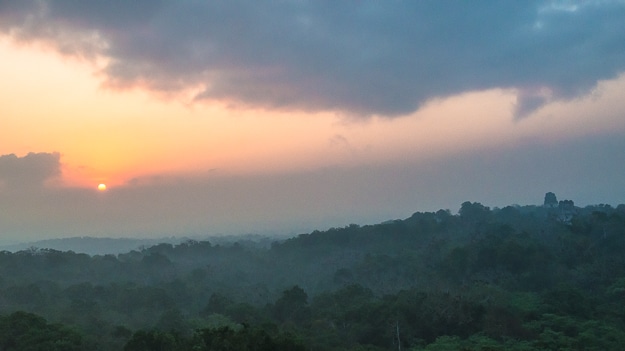
As we did at Chichén Itzá in Mexico’s Yucatan, we allowed three nights’ stay right inside the site of Tikal in northern Guatemala. We wanted to be sure to have plenty of time to wander among the Mayan ruins, including taking in a sunrise and sunset. Take our recommendation and you won’t have to worry about your arrival time at the site. Through no planning on our part (we are good at not planning) and after some intentional and unintentional detours en route from Belize, we arrived after 3 p.m. at the park entrance, still a few miles from the archeological site itself. The fee of 150 Quetzales each, about $20, gets you into the park for the remainder of that day and all the next day. It’s a nice benefit for late arrivals.
The Jungle Lodge Hotel is one of three onsite hotels in Tikal, a UNESCO World Heritage Site and National Park. The Lodge was built in 1952 for the scores of archeologists and other scientists who worked at the site for the next couple decades. Now it offers comfortable bungalows with ceiling fans and window screens, a pool, restaurant, gift shop, and a footpath to the site’s entrance gate about 50 meters away. Be prepared to charge your electronics when you can. Power throughout the park is restricted to a couple hours in the morning, an hour at midday, and four to five hours in the evening.
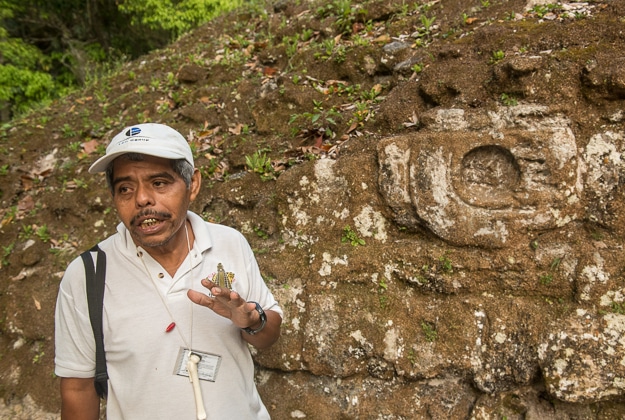
We chose to save our energy for the next day, and settled in to watch the Howler Monkeys and birds in the area. (It’s the Jungle Lodge, after all!) Like magic, as we checked in, a guide named Marcos Sep showed up at the hotel and offered to take us into Tikal for sunrise. Since admission to the park that early is only possible with a guide, we signed on. Our wake-up call (Marcos knocking on our door) was at 4 a.m.
A word on guides around Tikal. We paid about $35 each for our tour (and tipped Marcos almost 30%). The guides, however, receive less than half of that. The hotel takes their share, and the guides contribute to their self-administered association. They’ve established the group as a form of insurance. The group “takes care of each other,” offering financial assistance to guides with health or other emergency needs. If you can hire a guide directly, they fare much better.
For the next 5 hours, we walked and talked and laughed with Marcos, a 53-year-old of slight build but long memory and keen interests. Ask for him if you are able to take a tour in Spanish. He’s lived in the area all his life, worked in the jungle, and was a great bird and wildlife spotter, as well as well versed in the Mayan history and the archeological process.
In the dark, with our headlamps and Marcos’ bright flashlight, we were led into the site via the lagoon. Marcos pointed out several crocodiles whose eyes shined yellow, just at the water surface.
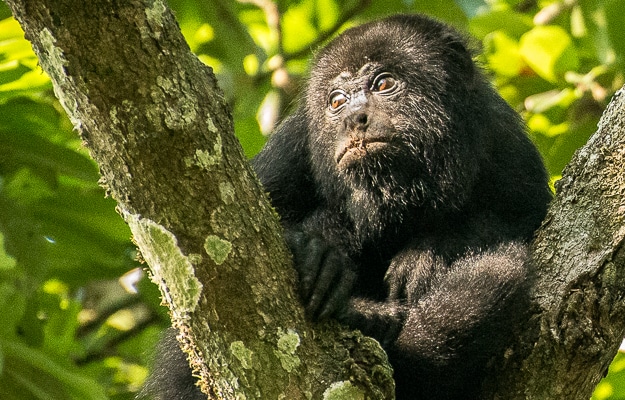
The object of the early morning hike was to reach Temple IV by sunrise. But we had no need to hurry and Marcos introduced us, in the dark, to the essential plants used by the Mayan citizens of Tikal – and by inhabitants since then. He provided a vivid picture: rubber trees, gum trees, palms, mahogany, figs; trees used for incense, for fire, drinking water, food, building or protection. We admired them all and learned a hell of a lot. For the next week we would enjoy seeing Ceiba trees, the national tree of Guatemala, with their tall straight trunks and huge buttresses.
Marcos was more than happy to detour for potential sightings, and we were rewarded by spotting a fox, spider monkeys, pheasants, turkeys, quail, parrots, toucans, and new-to-us species like the oropendola bird, a raccoon-like pizote and a rabbit-like sereque. All this was further benefit of going into the site at dawn and with a knowledgeable guide.
We made the easy climb up a wooden staircase to the top of Temple IV to watch the sunrise, left alone by Marcos but joined shortly after by a group of American students with iPhones and annoying snacks. The chatter subsided, though, as everyone took in the gorgeous sunrise. We weren’t viewing any Mayan monuments in the early light, but just the sun rising over the endless jungle.
After sunrise we walked slowly through various groups of temples and pyramids toward the central plaza and acropolis. Along the way, of course, we marveled at those crazy, accurate Mayan observations of the sky. At the “Lost World” group, for example, it is possible to see how the arrangement of pyramids and platforms coincides with the sun’s solstice and equinox positions.
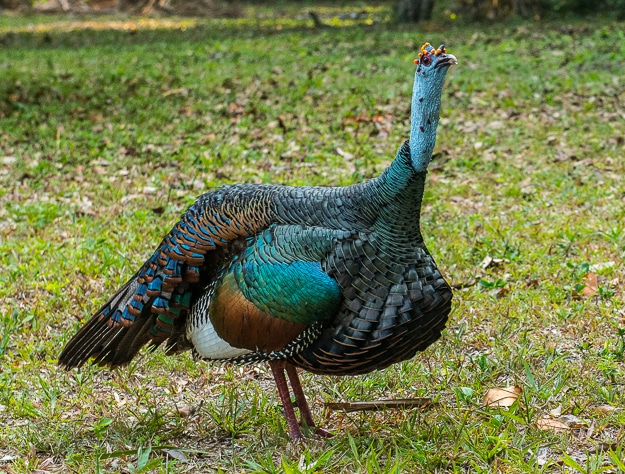
Tikal contains water along with all the rock. Eventually, we were able to distinguish the small limestone rocks that were burned and combined with fine limestone powder and water to make cement. This is a process archeologists rediscovered out of necessity when their modern version didn’t stick.
We returned later in the day without our guide to photograph the famous Jaguar Temple at sunset. But our eyes were open, and we observed more than we would have before our morning tour. We wanted to be quiet and imagine the time Mayans spent simply watching the natural world and learning how to live in it.
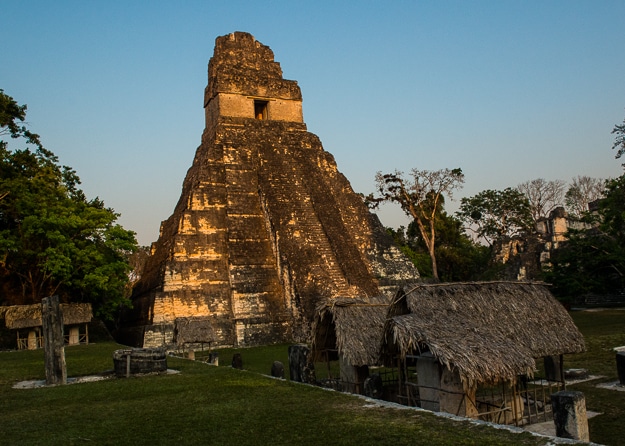
With our extra day, we visited the three museums on site. One is devoted to ceramic artifacts, another to changing exhibitions, and our favorite, the museum with photos of original explorations of the site in 1895.
While we thought we were pretty cool to have the two full days and three nights, others stay for a week or more to study and explore. The longer you look, the more you see.
Check out our post on the Guatemalan ruins at the lost city of El Mirador.
When you’re thinking of traveling, your first stop should be our Travel Resources page, where we list all the essentials you need to make your travels easier, cheaper, safer, and more fun.
We love traveling–with the right gear. We've gathered a lot of the stuff we use to make travel more pleasant and efficient all on one page. Shop our Travel Past 50 Amazon page to find our favorite gear. If you purchase something from the store, Travel Past 50, as an Amazon affiliate, may receive a small commission at no extra charge to you. Thanks.
We never leave home without our travel insurance. Nor should you. Search for the travel insurance from Allianz that best meets your needs, whether it be an annual plan or a single trip.
Note: This post and other posts on TravelPast50.com may contain paid or affiliate advertising links. As an Amazon Associate we earn from qualifying purchases.
Up Your Travel Skills
Looking to book your next trip? Use these resources that are tried and tested by us. First, to get our best travel tips, sign up for our email newsletter. Then, be sure to start your reading with our Resources Page where we highlight all the great travel companies and products that we trust. Travel Accessories: Check out our list of all the accessories we carry to make getting there and being there a lot easier. Credit Cards: See our detailed post on how to choose the right travel rewards credit card for you. Flights: Start finding the very best flight deals by subscribing to Thrifty Traveler. Book your Hotel: Find the best prices on hotels with Booking.com. See all of the gear and books we like in one place on our Amazon shop.Got a comment on this post? Join the conversation on Facebook, Instagram, or Threads and share your thoughts!


Comments are closed.